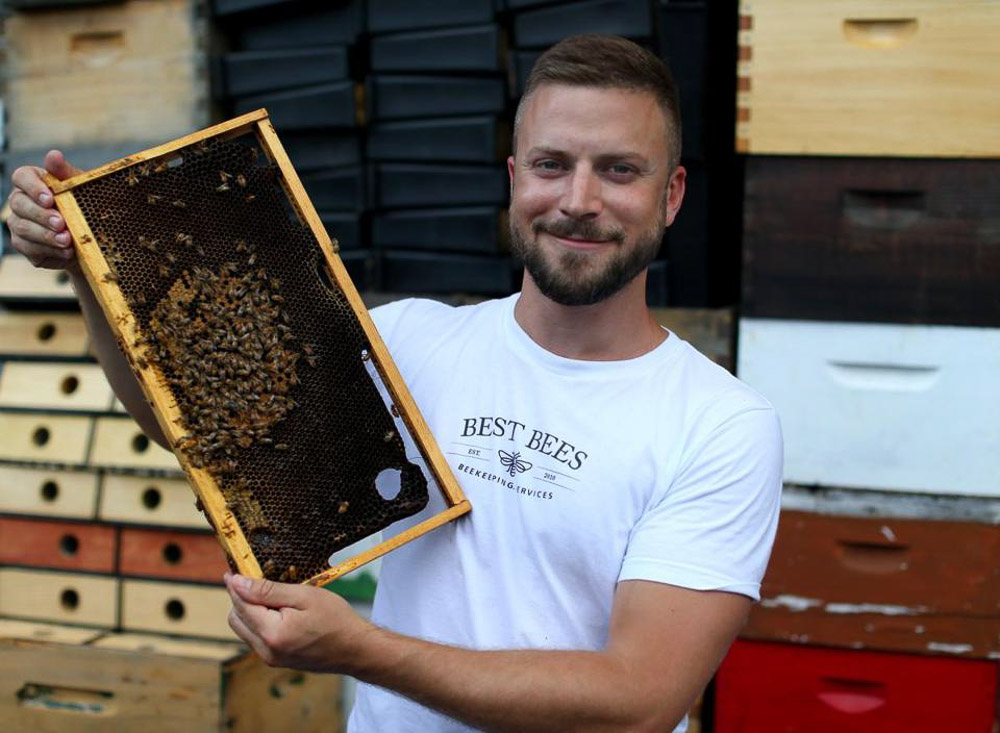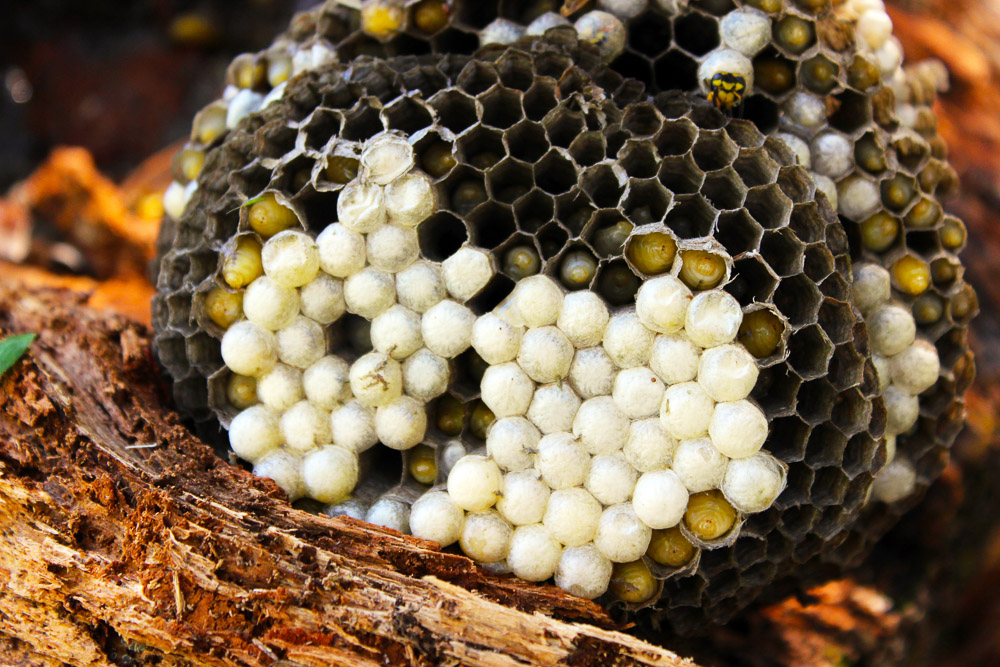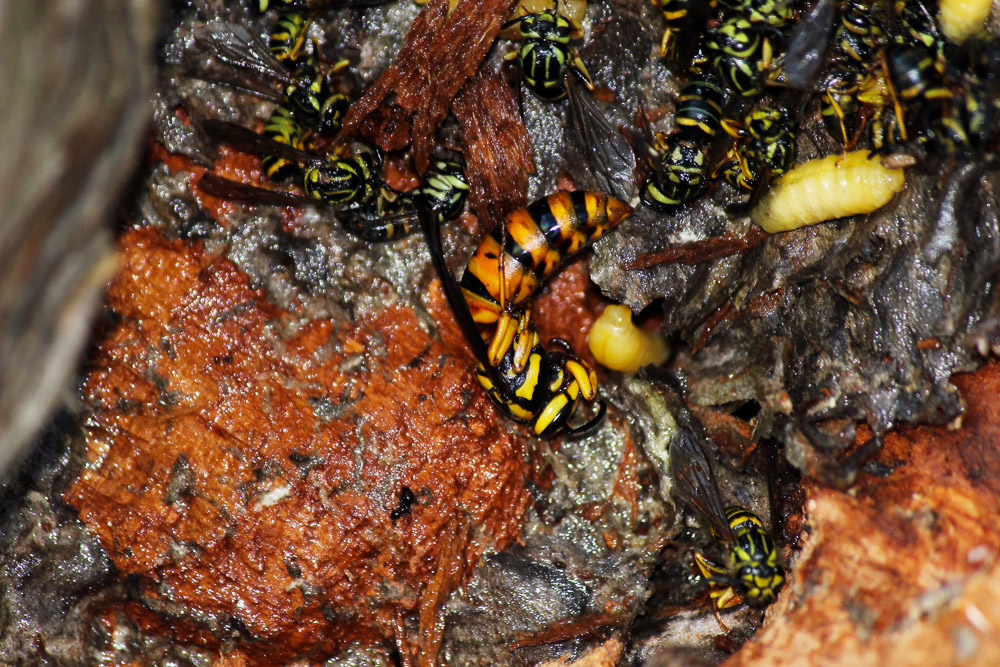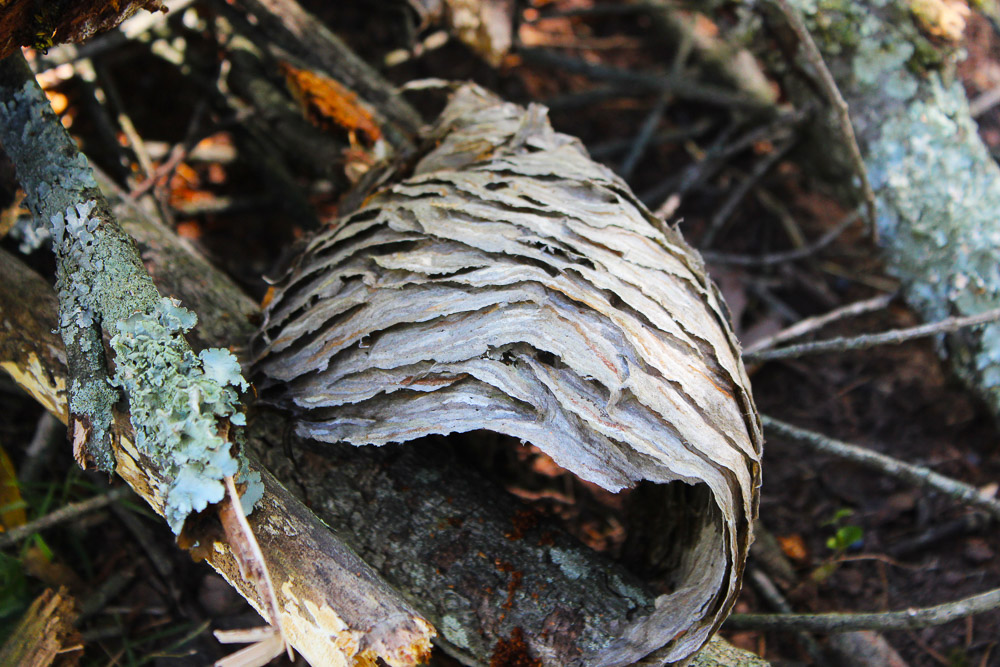In the heart of Linda Park’s garden, an unexpected encounter with a humble stump sets the stage for this story. This seemingly ordinary piece of wood, once deemed a mere “decorator garden item,” had a secret hidden within its rugged exterior. Unbeknownst to Linda, this stump held the intricate creation of nature itself – an eastern yellow jacket nest of the species Vespula maculifrons. But this is not just any story about an accidental encounter with nature’s architects. It’s a tale that unfolds through the lenses of two passionate individuals (Linda Park a nature photographer and the unfortunate discoverer of an in ground yellow jacket nest, and scientist Noah Wilson-Rich a behavioral ecologist and passionate bee expert), each bringing their unique expertise.
The Unforeseen Meeting with a Yellow Jacket Nest in A Tree Stump
The stump was a “decorator garden item” rescued from the side of the road a few years ago. I had moved it to the side of my house after using it to display a fairy garden. I knew nothing of the yellow jacket nest before I hit the stump while mowing the lawn. Within seconds, the yellow jackets had stung me three times on the face. When my husband responded to my screaming, he was stung in five places, right through his long pants. Thankfully, I was wearing a bee suit, but without the bee hat, things might have been much worse. We disbanded the nest with multiple treatments of pesticide, but weeks later my daughter discovered that there was still movement in the structure. Fascinated, (I am a nature photographer after all) I cautiously crept in for a closer, photographic look.
– Linda Park – Nature Photgrapher
An Expert’s Insight

Noah Wilson-Rich, Ph.D., is a distinguished figure in the world of insects and beekeeping. As the founder and Chief Scientific Officer of The Best Bees Company, Noah stands at the forefront of innovative beekeeping practices. Noah is also a prolific author, sharing his passion and knowledge through books that delve into the fascinating world of bees and insects. (His book – The Bee: A Natural History is not only fascinating but also one of the most beautiful science books I’ve ever seen – it makes a great gift).
Noah’s advocacy for beekeeping also includes a TED Talk. He has not only enriched the understanding of vital pollinators but has also inspired countless individuals to join the cause of preserving these remarkable creatures. His multifaceted background, from scientific leadership to literary contributions, paints a portrait of a dedicated expert whose work transcends the boundaries of conventional entomology, making him a true champion for the natural world.
We shared Linda’s fascinating nest images with Noah and he gave us a tour of inner workings and lives of Yellow Jackets that created it.
A Guided Tour of Nature’s Architecture With Noah Wilson-Rich
The structure is made from masticated (chewed) wood pulp, ground with saliva into a malleable paper. The hexagonal architecture in the comb resembles that of the hymenopterans (wasps, bees, and ants) cousins, such as the wax in honeybee nests.
Unlike bees, these wasps are carnivorous. At least for part of their life cycle, and they will eat pests such as aphids, flies, and even dead and decaying carrion.
Like bees, females do all the work, from nest construction to rearing brood (babies).
Note the developing brood here, from small larvae growing larger, until undergoing metamorphosis during their pupal stage within bulbous capsules. After which they finally emerge as an adult, like the one being born in the top right.

The Life Cycle of the Eastern Yellow Jacket
Like most wasp nests, easter yellow jackets (Vespula maculifrons) begin new nests in the springtime. They continue building them in size and complexity throughout the summer.
Come late fall, the populations boom and then crash. Exploding with mating assemblages followed by only a few, mated females overwintering off-site, in the attics of houses or in stone wall crevices.
These become the new foundresses the following spring.
Note the connected stalks between layers of infrastructure, providing remarkable stability in this natural architecture.

The Complex World of Social Insects
Yellow jackets are a type of wasp.
Adult yellow jackets are pollinators, feeding on nectar from plants while also transferring pollen between flowers. However, the adults also hunt insect larvae, often utilizing their venom with repeated stings. These adult females (remember, males do basically nothing other than mate) masticate (chew) their prey to pre-digest them before feeding this protein-rich food to developing larvae.
Wasps need to be aggressive by nature in order to feed their brood. Bees are not aggressive by nature because they are all vegan.
The queen lays eggs, while the workers rear up the brood (larvae).
Nesting Wonders
Nest architecture is complex for yellow jackets. Typically a yellow jackets nest is in ground. You can often find an underground wasp nest in abandoned holes created by other underground dwelling animals.
Vespula maculifrons can also be found in wood piles, within dense vegetation and in other enclosed or protected spaces. (In my yard, underground wasp nests have sprung up in chipmunk holes, in trees with many protective limbs, and under the treehouse floor).
Many unssuspecting homeowners will discover yellow jackets nests in the ground while mowing. In this case it was found in a tree stump and nests can alsbe be found in nests
Each wasp nest begins underground. One foundress (‘queen’) collects wooden material from plants, masticating it with her chewing mouthparts, and mixing it with sticky saliva to form a paper stalk structure.
She continues building a few compartments off the stalk, within which she lays one egg. Each of which looks similar to a grain of rice. The offspring are also female, and they become the queen’s workers. They take over nest construction, building hundreds more cells, with layers upon layers of sheeted, hexagonal infrastructure.
Social Insects’ Architectural Marvel
Social insects, including these wasps, are remarkable in their ability to design and build somewhat advanced architecture.
This wasp nest is created entirely from wooden pulp that wasps gnaw from trees and other plants, masticate with their chewing mouthparts, and combine with antimicrobial saliva as both a preservative and a form of preventative medicine for the nesting family.
This wasp nest is enclosed in a paper envelope, while nests of other wasps such as paper wasps (Polistes spp.) have an open nest architecture with the paper comb visible and exposed to the elements.

Make a colorful Wasp nest! – A Fun Project for Curious Minds
A fun experiment for science students is to collect a wasp nest from the field, install it into a meshed enclosure with sugar water and caterpillars for food, and colored construction paper. Within a few days to weeks, the wasps will construct the most amazing tie-dye paper nest! Supervision recommended, of course. – Noah
Additional intriguing facts about the Eastern Yellow Jacket (Vespula maculifrons):
- Colorful Variations: While their name suggests a yellow coloration, Eastern Yellow Jackets can exhibit varying shades of yellow, from pale yellow to deep, almost black hues, depending on their location and age.
- Stinging Arsenal: These wasps are equipped with potent venom and can sting repeatedly if they feel threatened. For those with allergies, these stings can be particularly dangerous, emphasizing the importance of cautious interactions.
- Resourceful Nesting Sites: Eastern Yellow Jackets are known for their adaptability in choosing nesting locations. They often select underground burrows, but they can also nest in wall voids, tree cavities, and even man-made structures, making them a common household pest.
- Complex Social Structure: Like many other social wasps, Eastern Yellow Jackets live in colonies with a well-defined social structure. The colony is typically headed by a queen, who lays eggs, while worker wasps tend to the nest, forage for food, and defend the colony.
- Seasonal Abundance: These wasps are most active during late summer and early fall, which coincides with the time when their populations are at their peak. During this period, they can become more aggressive, especially around food sources.
- Foraging Behavior: Eastern Yellow Jackets play a vital role as pollinators while foraging for nectar from flowers. However, their diet also includes scavenging for sugary substances and hunting small insects to feed their young.
- Lifespan and Hibernation: Worker yellow jackets have a relatively short lifespan, living for only a few weeks. However, the newly mated queens are equipped to survive the winter by hibernating in sheltered locations until the next spring, when they establish new colonies.
Written by: Rochelle Greayer
Photography & Story: LINDA PARK
Expert Notes: NOAH WILSON-RICH PH.D
comments +